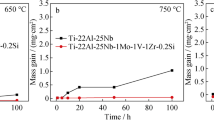Abstract
The isothermal and cyclic oxidation behavior of a multi-principal element (MPE) TiNbCr alloy at 800–1000 °C in air was studied and compared to Co-based alloy 188. The phase constitution of the MPE alloy consisted of a Nb-rich body-centered cubic (BCC) matrix and Cr-rich Laves precipitates. While isothermal tests conducted at 800 °C led to the formation of a complex mixture of Nb, Ti and Cr oxides, tests at 900 and 1000 °C resulted in the formation of an innermost Cr2O3-rich scale layer which provided improved oxidation resistance. However, for all exposure temperatures, the scaling kinetics of the alloy were linear and therefore deemed non-protective. In contrast, alloy 188 exhibited parabolic scaling kinetics and smaller mass gain per area than the MPE alloy. The similarity between isothermal and cyclic test results for the MPE alloy confirmed that the scale does not offer much protection. Additionally, for all tests, there was extensive internal oxidation and nitridation.



















Similar content being viewed by others
References
N. Birbilis, S. Choudhary, J. R. Scully, and M. L. Taheri, npj Materials Degradation 5, 2021 (1).
D. B. Miracle and O. N. Senkov, Acta Materialia 122, 2017 (448).
B. Cantor, Entropy 16, 2014 (4749).
E. P. George, D. Raabe, and R. O. Ritchie, Nature Reviews Materials 4, 2019 (515).
H. Shi, C. Tang, A. Jianu, R. Fetzer, A. Weisenburger, M. Steinbrueck, M. Grosse, R. Stieglitz, and G. Müller, Corrosion Science 170, 2020 (108654).
K. Chattopadhyay, R. Mitra, and K. K. Ray, Metallurgical and Materials Transactions A 39, 2008 (577).
B. Gorr, F. Mueller, H. J. Christ, T. Mueller, H. Chen, A. Kauffmann, and M. Heilmaier, Journal of Alloys and Compounds 688, 2016 (468).
B. Gorr, S. Schellert, F. Müller, H. J. Christ, A. Kauffmann, and M. Heilmaier, Advanced Engineering Materials 23, 2021 (1).
H. Jiang, M. Hirohasi, Y. Lu, and H. Imanari, Scripta Materialia 46, 2002 (639).
J. Stringer, Acta Metallurgica 17, 1969 (1227).
O. N. Senkov, D. B. Miracle, K. J. Chaput, and J. P. Couzinie, Journal of Materials Research 33, 2018 (3092).
N. R. Philips, M. Carl, and N. J. Cunningham, Metallurgical and Materials Transactions A 51, 2020 (3299).
O. Kubaschewski and B. E. Hopkins, Journal of the Less Common Metals 2, 1960 (172).
J. Hidde, C. Guguschev, and D. Klimm, Journal of Crystal Growth 509, 2019 (60).
T. M. Butler, O. N. Senkov, T. I. Daboiku, M. A. Velez, H. E. Schroader, L. G. Ware, and M. S. Titus, Intermetallics 140, 2022 (07374).
T. M. Butler, O. N. Senkov, M. A. Velez, and T. I. Daboiku, Intermetallics 138, 2021 (107323).
N. J. Welch, M. J. Quintana, T. M. Butler, and P. C. Collins, Journal of Alloys and Compounds 941, 2023 (169000).
HAYNES® 188® alloy. Nominal Composition. (n.d.). https://www.haynesintl.com/en/datasheet/haynes-188-alloy/#nominal-composition
R. B. Herchenroeder and H. A. No, 188 Aging Characteristics. International symposium on structural stability in superalloys, (1968), p. 110.
V. P. Deodeshmukh, S. K. Srivastava, and J. Bai, Materials and Corrosion 64, 2013 (772).
J. T. Clenny and C. J. Rosa, Metallurgical Transactions A 11, 1980 (1385).
K. P. Lillerud and P. Kofstad, Journal of the Electrochemical Society 127, 1980 (2397).
P. Kofstad and K. P. Lillerud, Journal of the Electrochemical Society 127, 1980 (2410).
H. C. Graham and H. H. Davis, Journal of the American Ceramic Society 54, 1971 (89).
F. Gesmundo and B. Gleeson, Oxidation of Metals 44, 1995 (211).
G. Wang, B. Gleeson, and D. L. Douglass, Oxidation of Metals 35, 1991 (317).
Acknowledgements
This study was financed in part by the Coordenação de Aperfeiçoamento de Pessoal de Nível Superior—Brasil (CAPES)—Finance Code 001. Work by I. Dainezi was financially supported through CAPES/PrInt—Coordenação de Aperfeiçoamento de Pessoal de Nível Superior/Programa Institucional de Internacionalização process n° 88887.696560/2022-00 and CAPES—Coordenação de Aperfeiçoamento de Pessoal de Nível Superior process n° 88887.500991/2020-00. Technical and financial support from the University of Pittsburgh. Dr. Butler from the Air Force Research Lab for his work on casting and HIPing in its HIPed condition and his availability to discuss analysis. Dr. Nunes and his research group from the DEMAEEL—USP (University of São Paulo) for their work on casting the TiNbCr alloy in its as-cast condition. PPGCEM/UFSCar (Graduate Program in Materials Science and Engineering/Federal University of São Carlos), the Brazilian research-funding agencies CNPq (National Council for Scientific and Technological Development – grant no. 406740/2021-6, 407624/2022-8, 315903/2023-6) and FAPESP (São Paulo Research Foundation – grant no. 2022/03139–9) for their financial support to this work.
Author information
Authors and Affiliations
Contributions
Isabela Dainezi contributed to conceptualization, methodology, formal analysis, investigation, data curation and writing—original draft, review and editing; Brian Gleeson contributed to conceptualization, methodology, formal analysis, investigation, data curation, supervision, funding acquisition, resources and writing—review and editing; Bruno Resende Buzatti contributed to methodology, formal analysis, investigation and data curation; Artur Mariano de Sousa Malafaia contributed to methodology, formal analysis, investigation, data curation and writing—review and editing; Carlos Alberto Della Rovere contributed to conceptualization, formal analysis, supervision, project administration, funding acquisition, resources and writing—review and editing.
Corresponding authors
Ethics declarations
Conflict of interest
The authors declare that they have no known competing financial interests or personal relationships that could have appeared to influence the work reported in this paper.
Additional information
Publisher's Note
Springer Nature remains neutral with regard to jurisdictional claims in published maps and institutional affiliations.
Rights and permissions
Springer Nature or its licensor (e.g. a society or other partner) holds exclusive rights to this article under a publishing agreement with the author(s) or other rightsholder(s); author self-archiving of the accepted manuscript version of this article is solely governed by the terms of such publishing agreement and applicable law.
About this article
Cite this article
Dainezi, I., Gleeson, B., Buzatti, B.R. et al. TiNbCr Multi-Principal Element Alloy Oxidation Behavior in Air at 800–1000 °C. High Temperature Corrosion of mater. (2024). https://doi.org/10.1007/s11085-024-10246-x
Received:
Revised:
Accepted:
Published:
DOI: https://doi.org/10.1007/s11085-024-10246-x




